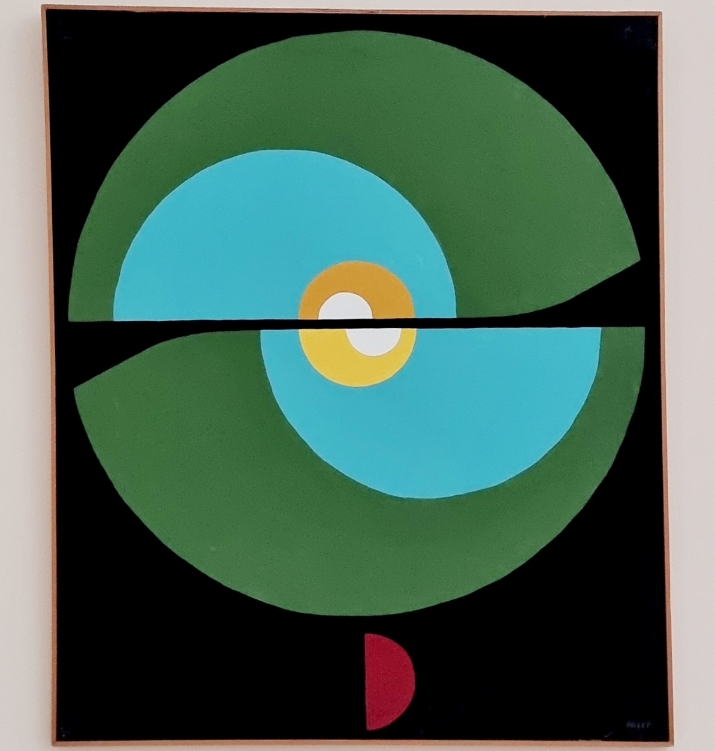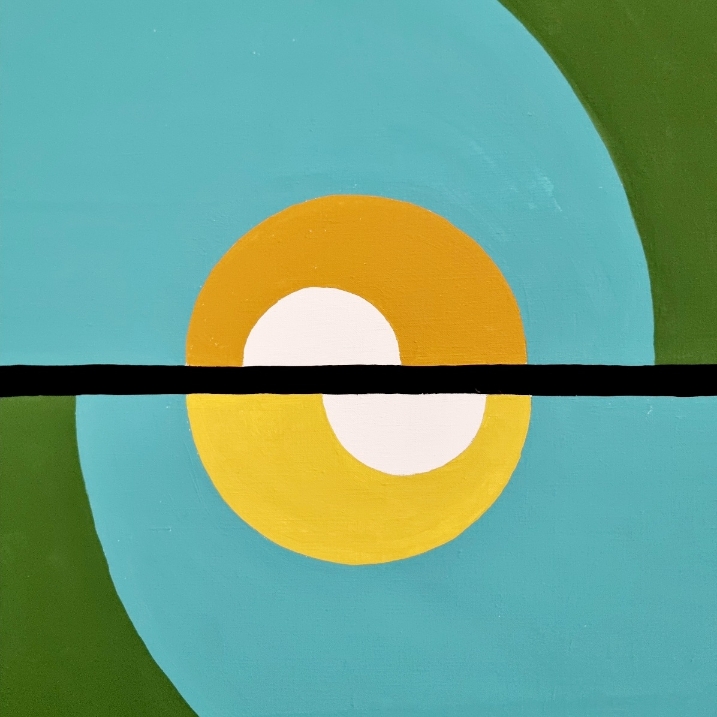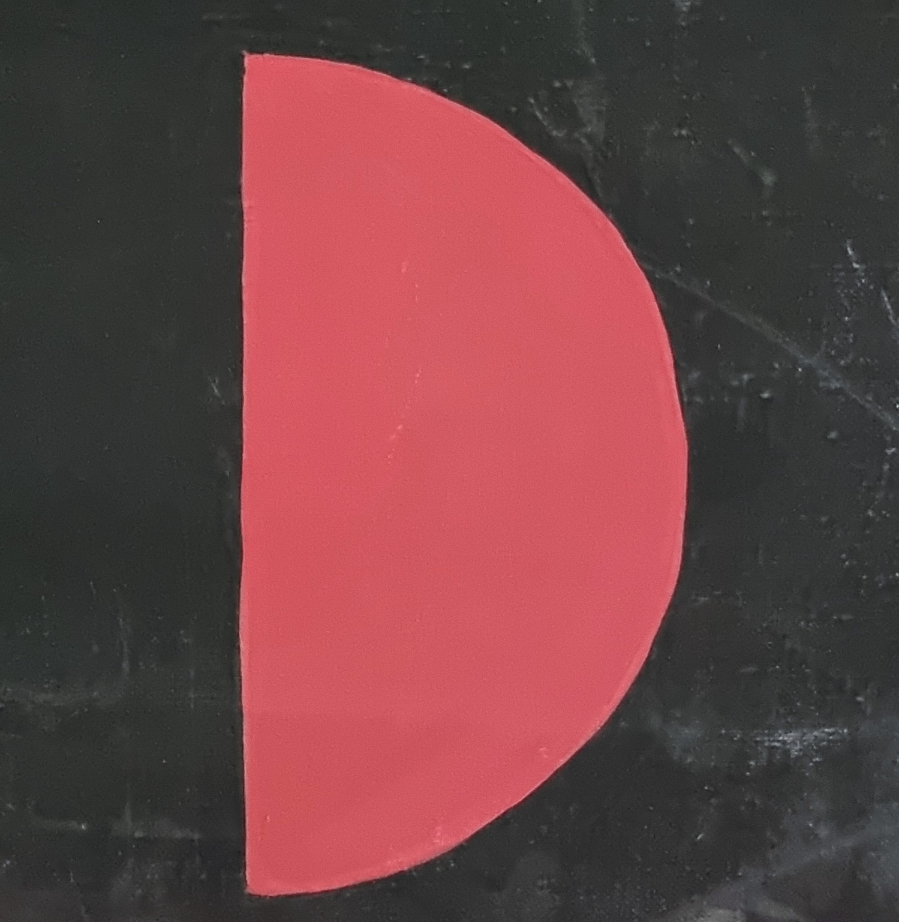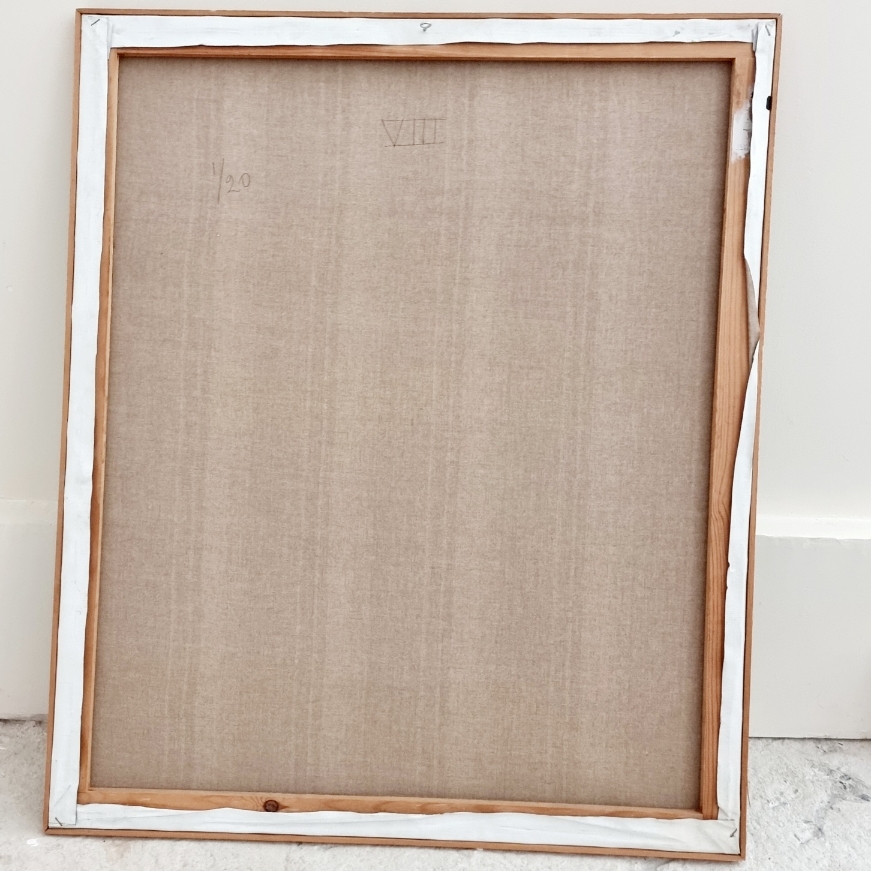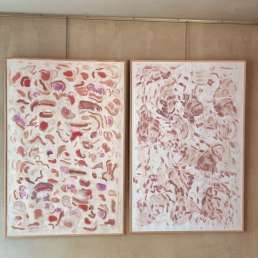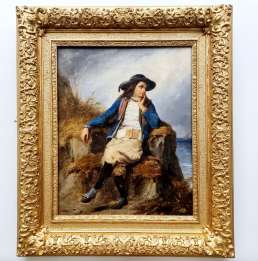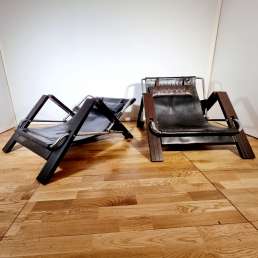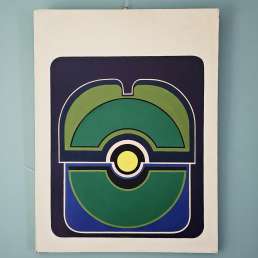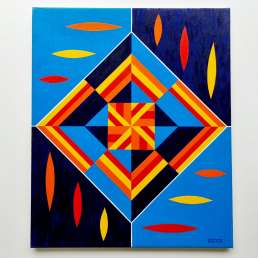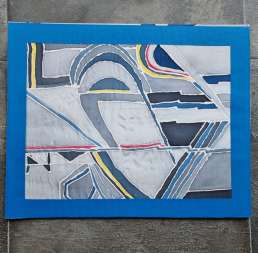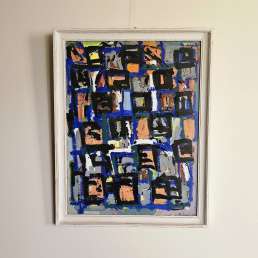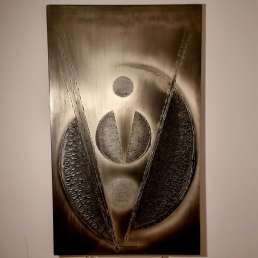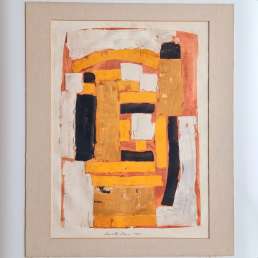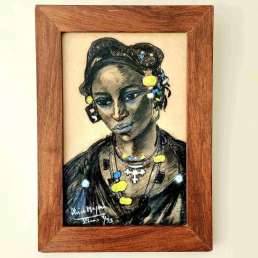Edgard Pillet, Composition, circa 1950-1951
Description
What I like
I like this painting because it is very typical of the current of geometric abstraction, with its forms, based on the circle with a rotational movement in the center, the red half-circle at the bottom animating the black background.
The colors are dynamic and the whole composition brings controlled movement.
I like the fact that it is signed by this extraordinary character that is Edgard Pillet: painter, after a figurative period for which he received the Abd El Tiff prize in 1939 and the Young Painting prize in 1948, he valiantly defends geometric abstraction and the synthesis of the Arts in the magazine “Art d’Aujourd’hui” which he created with the great architect-painter-sculptor André Bloc. At the time of our painting, he founded with Jean Dewasne the Atelier d’ArtAbstract, which became a center of avant-garde reflection and trained students like Agam or Dumitresco…Always at the time of our painting, he has a special exhibition at the Denise René gallery, which also exhibits Arp, Le Corbusier, Sotto… And in 1951, he founded the “Espace” group with André Bloc and Félix del Marle.
I like the fact that our painting is the materialization of this research, both intellectual and artistic, and that the great gallery owner Denise René, at the forefront of the French avant-garde from the post-war period until her death in 2012, supported Pillet.
This is a historical work, by a painter who is also a theoretician, a sculptor, a filmmaker… So many talents!!
Technical description
Edgard PILET (1912-1996)
Composition, circa 1950/1951
Oil on canvas signed lower right.
A few scratches.
Wooden chopsticks.
Dimensions and weight
Height: 100 cm – Width: 83 cm – Depth: 2 cm
Height: 39,7’’- Width: 32,7’’- Depth: 0,7 ‘’
Weight: 4 kg, 8 kg for postage
Mix & Match
It is a great work, both in terms of its size and its historical importance: it can therefore find its place among the most demanding collectors but also among connoisseurs!
Its strong visual impact, the strong colors, its architecture allow it to exist in all interiors: nevertheless, it will be necessary to dedicate a substantial section of the wall to it because this work must not be stifled by less demanding productions. On the other hand, on the other sections of the wall, we can hang abstract paintings, like our diptych by Charles Piquois, but also figurative works! Even our Young Breton painted around 1840 by Alexandre Marie Colin can withstand the shock, alongside other old works: the key is to respect the quality of the whole.
This obviously applies to the furniture: as with the great decorators of the 1970s, this Composition by Pillet can top a Louis XIV tortoiseshell and brass Mazarin desk, a beautiful Louis XV game table… I would also like to find the pair in this living room. G10 armchairs by Pierre Guariche upholstered in peacock blue cloth, with such taut lines! On the contrary, the Danish oak living room by Borge Jensen and Sonner will be able to give way to this colorful abstraction! Likewise the Grass Hopper armchairs by Sonja Wasseur!
We can also dare the orange of the pair of low armchairs in white lacquered metal, plastic and fabric: there is no doubt that we will be well seated there to meditate in front of our painting!
In stock
Description
To know more
The painter
Philip Edgard Pillet born July 29, 1912, in Saint Christoly de Médoc in Gironde where he spent his childhood.
1928-1934: Very young, he is obliged to earn a living but at the same time, he takes evening classes at the Ecole des Beaux-Arts in Bordeaux, then decides to “go to Paris” where he enrolls at the Beaux-Arts in Paris in the class of Mr. Boucher. It was Charles Despiau, whom he considered “his master”, who confirmed him in his vocation and finally offered him a vision of art to which he could join.
1936-1937: A state grant awarded on the advice of the Superior Council of Fine Arts introduces him to Greece where he will stay for almost a year with Hélène, whom he has just married.
For the first time in his life, free from financial worries, he affirmed his work as a classical sculptor and also trained in drawing.
Back in Paris, working on the site of the Universal Exhibition in Paris (Naïade for the house of Guyenne and Gascony), he had a decisive “encounter”: Picasso’s Guernica. All his subsequent work will be marked by it.
1939-1946: On the eve of the Second World War, a distinction – the Abd El Tiff prize -, awarded within the framework of the Ecole des Beaux-Arts, allows him to stay in this marvelous villa in Algeria where he devotes himself entirely in his art. Algiers immediately gives him another sense of moderation – or excess.
Algiers is also the place of decisive encounters: there he joins the circle of intellectuals formed around Albert Camus and Emmanuel Roblés.
Encouraged by Camus, with whom he became friends, Pillet devoted a good part of his time to writing, while continuing his work as a sculptor exhibited at the Galerie Colline in Oran. His first figurative and Cubist-inspired paintings are exhibited at the Galerie du Minaret in Algiers and Charlot publishes his collection “Plastique”, a booklet of aphorisms on art and artistic creation.
Edgard Pillet is remobilized from the beginning of the Allied troops on the coasts of North Africa, he is entrusted with the realization of the bust of Charles de Gaulle in 1943.
1945-1950: He meets André Bloc and proposes to him to create a new art magazine “Art d’Aujourd’hui”, of which he becomes general secretary. Until May 1954, he will hold the column “For a large debate”.
The magazine “Art d’Aujourd’hui” was founded by André Bloc, then director of “L’Architecture d’Aujourd’hui” and the painter Edgard Pillet to defend geometric abstraction and the synthesis of the arts. The magazine focuses on some big names in art criticism: Degand, Alvard, Gindertael, Estienne, Seuphor, etc.
Until May 1954, he will hold the column “For a large debate”. Pillet, back in Paris, settled in the studio at 9 rue Campagne Première, which he left in 1970. Again work, again the difficulties of life – and food literature – in the form of detective novels (pseudonym Arshie Kay).
After seven years spent far from the metropolis, the art he finds in Paris is “discovery” and “revelation”: it is Abstract Art. He will admit having been particularly marked by the art of Arp, Brancusi, Kupka, Kandinsky and Magnelli. He is gradually embarking on this path that he will never leave.
1948: The Prize for Young Painting is awarded to Pillet for a very transposed figurative canvas “the Young Woman with a Hat” which has since disappeared. He exhibited in many group salons in Paris. First known realization of cut-out paper collages to illustrate “Justine or the Misfortunes of Virtue” by Sade. At the time, Sade was in hell and the album of serigraphs resulting from these collages was not published until 1990. He assumed the functions of literary critic at the Gazette des Lettres and interviewed – with sketches – in this capacity various writers (Jouhandeau, Mac Orlan, Robert Merle among others).
1949: He meets André Bloc and proposes to him to create a new art magazine “Art d’Aujourd’hui”, of which he becomes general secretary. Until May 1954, he will hold the column “For a large debate”.
The Art d’Aujourd’hui magazine was founded by André Bloc, then director of L’Architecture d’Aujourd’hui and the painter Edgard Pillet to defend geometric abstraction and the synthesis of the arts. The magazine focuses on some big names in art criticism: Degand, Alvard, Gindertael, Estienne, Seuphor, etc.
Until May 1954, he will hold the column “For a large debate”.
1950: Pillet’s commitment to abstract art goes beyond simple making. With Jean Dewasne, he founded L’atelier d’ArtAbstract at 14 rue de la Grande Chaumière in Montparnasse, which has an international reputation: technical and philosophical conferences with actors from the art world (the critics Degand, Descargues, Seuphor, ..), studio visits and discussions of student work (Agam, Dumitresco, Wilfredo Arcayâ).
He will also respond with his pen to the controversy launched by Charles Estienne “Is abstract art an academicism?”
1951: Foundation of the “Espace” group, for which Pillet is responsible for communication (André Bloc is president and Félix del Marle general secretary). Private exhibition at the Galerie Denise René, followed by several group exhibitions including “Diagonale” in Paris and “Klarform” presented in Paris, Copenhagen, Oslo, Stockholm, Helsinki which exhibits around twenty artists chosen from among the pioneers of art abstract, Herbin, Léger, Le Corbusier, Arp, Poliakoff.
Pillet shoots “Genesis” an animated film whose actors are simple geometric elements, lines, squares, circles… which play with each other, intersect, come together, combine and then move away. This short film, an important milestone in the history of French abstract art, was purchased by the National Museum of Modern Art from the Center Pompidou in 1980. It is regularly presented at art film festivals.
1955-1957: Pillet leaves for the United States to teach at the University of Louisville, Kentucky, then at the Art Institute of Chicago for two years. There he works as a defender of contemporary French art and gives several conferences on this theme.
In the book “The world of abstract art” he presents the currents of constructive art, lyrical abstraction, abstract impressionism in France which he illustrates with works by his contemporaries. (Soulages, Mathieu, Vasarely among others)
In contact with American artistic circles and a privileged contact with Jakson Pollock, his painting will evolve towards more lyricism and graphics. Six exhibitions mark his stay in the United States. Among others at the Rose Fried Gallery in New York, the Zoe Dusanne Gallery in Seattle and the Cliff Dwellers in Chicago.
One of his students, Léo Zimmerman publishes an album of 8 art offsets by Pillet distributed in 1000 copies in the United States, Japan and Finland. But the artistic circles of the United States were then too involved in the promotion of Abstract Expressionism and of New York as the new capital of art and Pillet decided to return to Europe.
1958-1960: Europe, after three years of absence, offers him new stimuli and numerous personal and collective exhibitions.
Salon des Réalités Nouvelles, Salon de mai, Salon Comparaisons in Paris, Turin Biennale, Exhibitions in Lisbon, Havana, Charleroi, Copenhagen, London, Seattle and at the Craven Gallery in Paris.
The Bielefeld Museum (Germany) bought 2 recent paintings from him, Carrousel and Chicago mood, and the National Contemporary Art Fund, L’enclos (on deposit at the French Embassy in Canberra, Australia) and Composition bleue.
Pillet continues his dual activity as a painter and graphic designer. His latest pictorial research naturally leads him to express himself in engraving. The Lacouriére workshops will happily publish and distribute his etchings and aquatints. Some of them can be found at the Museum of Modern Art in New York and at the Museum of Modern Art of the City of Paris.
1960-1965: Instead, as was fashionable, of opposing geometry and lyricism, Pillet refuses this sterile debate and orients himself towards depth by starting the dialogue between form – colors – materials of his “crucibles” where “Il shows both space and time” (Jean-Jacques Lévêque, 1965).
A very prolific period when he produced nearly 300 crucibles, most of which are now dispersed.
Several European personal exhibitions explain this dispersion: Marcelle Dupuis in Paris and Drian Gallery in London in 1961, Kaare Bernstein in Oslo in 1962, Edouard Loeb and Edouard Smith in Paris in 1964.
At the same time, he is present in many fairs and exhibitions where one can see his crucibles, paintings, engravings or collages, but gradually loses interest in the gallery environment to devote himself to other and new adventures.
1965-1970: Pillet discovered the village of Carboneras in Andalusia in 1962 and it is the dazzle of a small fishing village in a wild and preserved nature. He becomes an architect and will build seven villas for himself and a group of friends including Dr. Tomatis.
Pillet will stay every summer for about ten years with Annick, his young companion at the time, in this corner of paradise where he has taken Bloc, Sotto, Lady Norton and other intellectuals with him. He works there in his studio installed in a tower overlooking the desert on one side and the sea on the other. The sands that make some of these crucibles vibrate originate from the beach of Carboneras.
Gradually, he moves away from painting and his “easel crucibles”. These will become sculptures in their own right, surface animation and lead him to rework in liaison with architects, such as Olivier Clément Cacoub with whom he will carry out numerous monumental projects in France and Africa.
1970: Pillet continues his work in connection with architecture which will mobilize him for another ten years.
We owe him around fifty works, mainly in educational settings, which he produced as part of the 1% (see footnote). Stainless steel, cement concrete, stone, mosaic, wood, stone, aluminum, marble…
Pillet uses a variety of materials adapted to the location and budgetary constraints of its sponsors. In 1970, he left the rue Campagne Première to settle in the Passage Ricaut. He will remain there until the end of his life, dividing himself between this workshop and the one he will soon obtain in Nogent sur Marne in the park of the National Foundation for Graphic and Plastic Arts.
1972: Prize for young sculpture for a surface animation project “the drums” in stainless steel
1970-1973: By chance he discovered a stock of colored feathers, survivors of a time when they adorned women’s hats. He is enthusiastic about this new “material” and explores its possibilities. This is the astonishing series of “feathers” by Pillet presented at the Galerie André Zerbib in Paris in 1973. Always in new research, Pillet invents the “multiple in collage”: from templates and colored papers.
The living wall presented in 1969 at the Maison de la radio in Paris was already an example of this same multiple approach applied this time to sculpture: a kind of claustra to be constantly recomposed from a single element, a kind of parallelepiped to seven sides.
1974-1980: Pillet fell in love with “La Commanderie” on Ile Bouchard in Touraine.
The Carboneras period is over. He will be the “Commander” of this small dream castle where he will spend at least every summer for the next 10 years surrounded by an incessant ballet of friends.
1980-1989: Pillet is seventy years old. He returns to his old loves, easel painting and writing novels.
His play “Le Placard” will also be performed in Châtellerault in 1986 while at the same time a retrospective is dedicated to him at the Municipal Museum of Poitiers in La Redoute. He now lives with Sylvie and her children with whom he will end his life, finding a new stimulation in exchanges with a generation of teenagers that it fascinates. From 1985 Sylvie’s house near Montargis will replace La Commanderie which he has just sold. A few private exhibitions in Paris at Marion Meyer, Jacques Barbier, J.P. previous works. Extremely prolific period when Pillet juxtaposes the series, “Sand”, “Jardins”, “Mandrake”, “electricity”, “Reds” in a pictorial explosion with creations that are sometimes jubilant and rhythmic, sometimes austere or more serene, which combine language from the heart, warmth, passionate feeling with perpetual rigor.
1990: Cimaise devotes its front cover of the summer issue to it, a nod to that of 1954 with an article by Martine Arnault putting 50 years of creation into perspective.
1991-1992: two videos are devoted to him: one shot by Bruno Brouard, and produced by Françoise Monin (D’art D’art), the other by Liliane Thorn Petit in Portraits d’artistes.
1994-1995: Returns to Finland where the Alvar Aalto Museum in Jyväskylä in Finland invites him, in recognition of the influence he had on Finnish painting. “Couleur-forme-variation” puts into perspective the works of Pillet, Sam Vanni and Carlstedt in an exhibition which will also be presented at the Amos Anderson Art Museum, Helsinki, Finland
1996: Death of Edgard Pillet in September in Paris.
A beautiful authentic painting at a fair price
This work by Edgard Pillet has been carefully selected for its aesthetic qualities, its originality and its fair price. Our choice favors above all the creativity of the artist and his involvement in the artistic debates of the moment, guarantee of a valuation of your new acquisition in your interior and of an ability to dialogue with your furniture, to agree and to mix together to create a unique decoration.
Buying works of geometric abstraction is surely a reasonable investment, so great is the appetite for this post-war movement.
Additional information
| Weight | 4 kg |
|---|---|
| Dimensions | 100 × 83 cm |
| Créateur | |
| Epoque |


